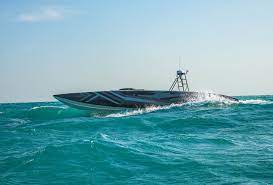Saildrones can be outfitted with a range of sensors. The version of the robotic surfer that Popular Science selected for a 2021 Best of What’s New award was used by NOAA to track hurricane winds. The drones can carry sensors for wind speed and direction, for air temperature and humidity, for measuring the salinity and magnetic field of the ocean surface, and even for detecting fish biomass and mammal presence under the surface. In addition, the Saildrones can record above-the-surface video and use machine learning algorithms to detect targets. This is one of the main features the Navy is interested in.
The cameras and processing on the Saildrone “deliver real-time, visual detection of targets that are otherwise not transmitting their position,” the company claims, which can then be paired with radar, acoustic sensors, and other detection systems to confirm a sighting.
“We are working harder and smarter to achieve maritime security, in all domains – surface, subsurface, and over the sea,” Hisham Khaleel Aljarrah, commander of the Royal Jordanian Naval Force, said in a joint statement with the Navy. “The Red Sea will witness a significant increase in monitoring and power projection to maintain stability and security within international waters.”
Michael Brasseur, head of the Navy task force for robots and AI managing Saildrone, described in a statement the robots as leveraging “machine learning and artificial intelligence to enhance maritime domain awareness,” which then extends “the digital horizon with a sustainable, zero carbon solution.
That’s a jargon-dense phrase. In practice, it means that having cameras and other sensors on the drones extends the area in which the Navy can know what is going on. With wind-driven propulsion and solar-powered electronics, the Saildrone suggests a lower impact operation, though it is too early to say if these robots are going to replace existing human-crewed vessels. Instead, the adoption of robot boats should be seen as expanding on existing naval operations, with little increase to impact.
Saildrone is one of several Silicon Valley products to be pursued by the Department of Defense this year. Lux Capital, the venture capital group that backed Saildrone, met with senior defense officials earlier this year. Lux boasts specifically of Saildrone as an alternative to more-expensive crewed vessels, highlighting an estimated $80,000/day operating cost for traditional scientific research. It’s hard to compare directly without a public operating cost per day figure for Saildrones, or how much operational capability is lost in the transfer from a human crewed vessel to a robotic one, but it’s worth noting that the Saildrone is being marketed on a low cost of use as well as the abilities of the machines.
Source : https://www.popsci.com/technology/us-navy-tests-ocean-robots/







